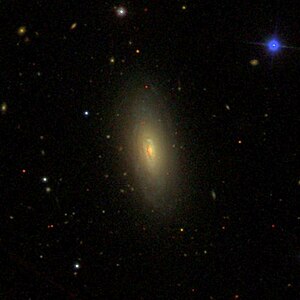NGC 2844
| Galaxy NGC 2844 |
|
|---|---|

|
|
| SDSS recording | |
| AladinLite | |
| Constellation | lynx |
|
Position equinox : J2000.0 , epoch : J2000.0 |
|
| Right ascension | 09 h 21 m 48.0 s |
| declination | + 40 ° 09 ′ 05 ″ |
| Appearance | |
| Morphological type | SA (r) a: / HII |
| Brightness (visual) | 12.8 mag |
| Brightness (B-band) | 13.7 mag |
| Angular expansion | 1.7 ′ × 0.8 ′ |
| Position angle | 13 ° |
| Surface brightness | 13.0 mag / arcmin² |
| Physical data | |
| Redshift | 0.004957 +/- 0.000033 |
| Radial velocity | 1486 +/- 10 km / s |
|
Stroke distance v rad / H 0 |
(66 ± 5) · 10 6 ly (20.3 ± 1.4) Mpc |
| history | |
| discovery | William Herschel |
| Discovery date | March 18, 1787 |
| Catalog names | |
| NGC 2844 • UGC 4971 • PGC 26501 • CGCG 209-057 • MCG + 07-19-064 • IRAS 09186 + 4021 • 2MASX J09214802 + 4009043 • GC 1826 • H III 628 • LDCE 628 NED002 | |
NGC 2844 is a spiral galaxy with extensive star formation regions of the Hubble type Sa in the constellation Lynx in the northern sky . It is estimated 66 million light years away from the Milky Way and has a diameter of about 35,000 ly.
In the same area of the sky are the galaxies NGC 2838 , NGC 2852 , NGC 2853 , among others .
The object was discovered by Wilhelm Herschel on March 18, 1787 .
